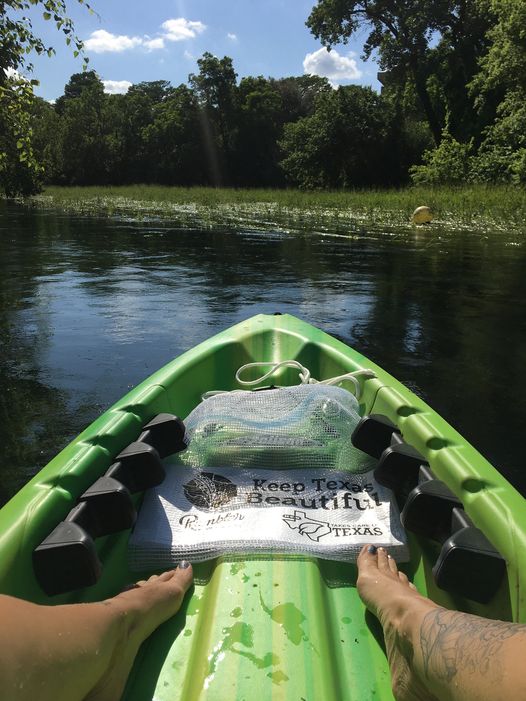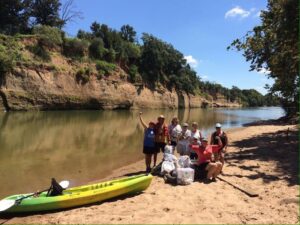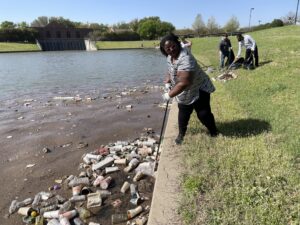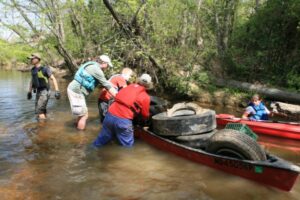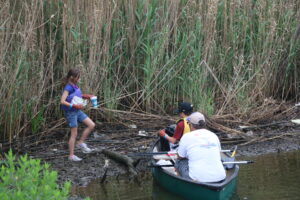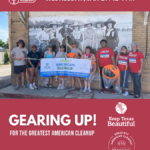Cleaning up waterways presents unique challenges and often requires extra preparation compared to other locations. Some of our affiliates have provided their tips and tricks to ensure a safe, smooth, and successful waterways cleanup.
Choosing a Cleanup Location & Planning Ahead
- Do your due diligence ahead of time: learn how your waterways work, is it a lake? Is it a creek, river? Where does the trash go on windy days? Are there any animals or important vegetation? (Keep Pearland Beautiful)
- Consider where the trash is coming from. Try focusing cleanup efforts on tributaries and smaller waterways to prevent further accumulation in major waterways. (Keep Polk County Beautiful)
- Follow the areas where trash accumulates after storms. Work with the stormwater people in your city to identify these locations. Waterway cleanups don’t have to be restricted to lakes, streams, rivers or oceans! (Keep Rowlett Beautiful)
- Stop litter at the source: clean up storm drains. People think that storm drains serve as a trash disposal or recycling bin. A lot of this material can be recycled, so educating everyone that recycling, and stormwater management must go hand in hand. If you dispose of waste appropriately, this material does not end up down the storm drains and won’t end up in our waterways. The city has started to paint their storm drain inlets blue to help educate the community that Only Rain should go down the storm drains. (Keep San Juan Beautiful)
- Scout your waterway out days before your event (at least) to think about any particular location-specific challenges, or contingencies to plan for. (Keep Gun Barrel City Beautiful)
- Make sure there is adequate parking and safe accessibility to the waterway. (Keep Pearland Beautiful)
- Identify the areas along the waterway which accumulate the most trash. Pre-plan locations to off-load bags of trash along the way. (Keep Smithville Beautiful)
- Have a plan for to handling large items. First time we went in, I did not think we would find tires or a bicycle…. but we did and thankfully we had a way to dispose of it. (Keep Pearland Beautiful)
Volunteers
- Reach out to local diving programs or diving equipment stores to get more volunteers. A local dive shop near us has its students come to our cleanups to accrue diving hours since they can dive into the lake/river while picking up litter. This brings a lot of people to our waterway cleanups since they need hours to receive their diving certification. (Keep Canyon Lake Beautiful)
- Try reaching out to civic groups and corporations as a way to give back to the community- waterways clean-ups are a great team-building exercise. (Keep Richardson Beautiful)
- Partner up for larger reach. We include the river clean up as part of our Adopt-a-Highway clean up. We work with a partner to joint market everything and work together to gain more volunteers. (Keep Victoria Beautiful)
- Kids can volunteer too! Waterways are not always dirty or deep. Check on the location first to know what ages to accept. (Keep Pearland Beautiful)
- Try out incentives. As part of our river race, kayakers earned extra points for the amount of trash they pick up – so they were incentivized and it worked! (Keep Victoria Beautiful)
- Cleanups can be fun! After every litter collection/audit done by our volunteer groups, the consensus is they learned a lot, were amazed by what they recovered from around the water, and “had a great time” or “who knew counting litter could be this fun?” (Keep The Woodlands Beautiful)
Equipment
- Bring several lengths of rope to tie full trash bags to kayaks. It may be OK to let bags trail behind the kayak because they float. (Keep Smithville Beautiful)
- Consider the best boat. Shorter kayaks are more maneuverable but have less storage. Canoes have more on-board storage but are less maneuverable. More trash may fit on sit-on-top kayaks. If possible, pair up various combinations of canoes and kayaks to combine their attributes. (Keep Smithville Beautiful)
- Consider tandem kayaks to allow a child (over 7 years of age) to join their parents. (Keep Grapevine Beautiful)
- Long pickers and paddles are both effective. Bring spare pickers as replacements, just in case. (Keep Smithville Beautiful)
- Try using plastic buckets instead of onion bags. A local BBQ restaurant gives us their pickle buckets and we just drill holes in the bottom for drainage. It makes the whole collection process a lot easier on volunteers and they don’t get snagged on things. (Keep Tyler Beautiful)
- Get long handled fishing/minnow nets. They are helpful in getting floating trash out of canals and hard to reach places. One volunteer scoops litter on to the shore, water drains, and then we use grabbers to get it all picked up. Definitely use gloves, this can get messy. (Keep Lewisville Beautiful)
- Don’t lose your grabber in deep water. We’ve had volunteers put a kid’s arm floaty on their litter grabber so that if they dropped it in deeper water, it doesn’t get lost to the fishes. You can also tie a rope to the handle end and secure it to the boat. (Keep Lewisville Beautiful)
- Bring a wagon or cart of some kind for hauling trash to dumpsters. (Keep Nacogdoches Beautiful)
- Bring nets and onion bags for floatables that may disintegrate or are especially small. (Keep The Woodlands Beautiful)
- Take a “Stabilizing Stick” – you never know how deep a small section of water can be. (Keep Pearland Beautiful)
Attire
- Volunteers should wear waders or waterproof shoes in case they end up in the water for the creek cleanups. (Keep Tyler Beautiful)
- Bring water/rain boots, and wear long pants instead of shorts. (Keep Nacogdoches Beautiful).
- Wear safety vests. Safety vests worn during cleanups often lead to higher visibility/great conversations with community members around the cleanup efforts, which has led to more participation and greater awareness! (Keep The Woodlands Beautiful)
Safety
- Hand out laminated cards that show types of poison ivy common in area. Talk about venomous snakes. (Keep Lewisville Beautiful)
- Check the forecast and don’t go into a watershed after a recent rain. (Keep Lewisville Beautiful)
- Educate kids on avoiding stagnant water. (Keep Lewisville Beautiful)
- Always use grabbers or another tool– don’t stick your hands in water you can’t see. (Keep Lewisville Beautiful)
- Implement safety talks around health hazards in the water such as bacteria levels, as well as extensive training on staying out of the water, such as best practices to avoid falling in. (Keep The Woodlands Beautiful)
- Have a designated contact person on shore who stays behind in case of emergency. (Keep Gun Barrel City Beautiful)
- Work with the Coast Guard. Our area’s Coast Guard Auxiliary joins us for all waterway cleanups. After we do our welcome, the Coast Guard provides a brief water safety talk. The Coast Guard ensures kayakers are safe and assists with removing large debris that cannot be managed by volunteers. (Keep Grapevine Beautiful)
- We require volunteers to have prior kayaking experience. (Keep Grapevine Beautiful)
Looking to plan a waterway cleanup in your community? Check out our Keep Texas Waterways Clean program, which provides cleanup supplies to eligible groups across Texas.
Thank you to the affiliates who provided all of this helpful information!
